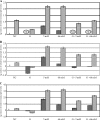D-Xylose as a repressor or inducer of xylanase expression in Hypocrea jecorina (Trichoderma reesei)
- PMID: 20097821
- PMCID: PMC2838004
- DOI: 10.1128/AEM.02746-09
D-Xylose as a repressor or inducer of xylanase expression in Hypocrea jecorina (Trichoderma reesei)
Abstract
For Hypocrea jecorina (anamorph Trichoderma reesei), a filamentous fungus used for hydrolase production in different industries, it has been a long-term practice to use d-xylose as an inducing substance. We demonstrate in this study that the degree of xylanase-encoding gene induction strictly depends on the concentration of d-xylose, which was found to be optimal from 0.5 to 1 mM for 3 h of cultivation. At higher concentrations of d-xylose, a reduced level of xylanase gene expression was observed. In the present study, we also provide evidence that the d-xylose concentration-dependent induction is antagonized by carbon catabolite repressor 1. This repressor mediates its influence on d-xylose indirectly, by reducing the expression of xylanase regulator 1, the main activator of most hydrolase-encoding genes. Additionally, a direct influence of the repressor on xylanase 1 expression in the presence of d-xylose was found. Furthermore, we show that d-xylose reductase 1 is needed to metabolize d-xylose to achieve full induction of xylanase expression. Finally, a strain which expresses xylanase regulator 1 at a constant level was used to partially overcome the negative influence exerted by carbon catabolite repressor 1 on d-xylose.
Figures







Similar articles
-
L-arabitol is the actual inducer of xylanase expression in Hypocrea jecorina (Trichoderma reesei).Appl Environ Microbiol. 2011 Sep;77(17):5988-94. doi: 10.1128/AEM.05427-11. Epub 2011 Jul 8. Appl Environ Microbiol. 2011. PMID: 21742908 Free PMC article.
-
Xyr1 (xylanase regulator 1) regulates both the hydrolytic enzyme system and D-xylose metabolism in Hypocrea jecorina.Eukaryot Cell. 2006 Dec;5(12):2128-37. doi: 10.1128/EC.00211-06. Epub 2006 Oct 20. Eukaryot Cell. 2006. PMID: 17056741 Free PMC article.
-
A modified expression of the major hydrolase activator in Hypocrea jecorina (Trichoderma reesei) changes enzymatic catalysis of biopolymer degradation.Catal Today. 2011 Jun 10;167(1):122-128. doi: 10.1016/j.cattod.2010.12.038. Catal Today. 2011. PMID: 27667900 Free PMC article.
-
[Transcriptional regulation of cellulases and hemicellulases gene in Hypocrea jecorina--a review].Wei Sheng Wu Xue Bao. 2010 Nov;50(11):1431-7. Wei Sheng Wu Xue Bao. 2010. PMID: 21268886 Review. Chinese.
-
Regulation of transcription of cellulases- and hemicellulases-encoding genes in Aspergillus niger and Hypocrea jecorina (Trichoderma reesei).Appl Microbiol Biotechnol. 2008 Feb;78(2):211-20. doi: 10.1007/s00253-007-1322-0. Epub 2008 Jan 16. Appl Microbiol Biotechnol. 2008. PMID: 18197406 Review.
Cited by
-
Genome-wide transcriptomic analysis of a superior biomass-degrading strain of A. fumigatus revealed active lignocellulose-degrading genes.BMC Genomics. 2015 Jun 16;16(1):459. doi: 10.1186/s12864-015-1658-2. BMC Genomics. 2015. PMID: 26076650 Free PMC article.
-
Enzyme production by filamentous fungi: analysis of the secretome of Trichoderma reesei grown on unconventional carbon source.Microb Cell Fact. 2011 Aug 23;10:68. doi: 10.1186/1475-2859-10-68. Microb Cell Fact. 2011. PMID: 21861877 Free PMC article.
-
Deletion of either the regulatory gene ara1 or metabolic gene xki1 in Trichoderma reesei leads to increased CAZyme gene expression on crude plant biomass.Biotechnol Biofuels. 2019 Apr 9;12:81. doi: 10.1186/s13068-019-1422-y. eCollection 2019. Biotechnol Biofuels. 2019. PMID: 31007715 Free PMC article.
-
Transcriptional comparison of the filamentous fungus Neurospora crassa growing on three major monosaccharides D-glucose, D-xylose and L-arabinose.Biotechnol Biofuels. 2014 Feb 28;7(1):31. doi: 10.1186/1754-6834-7-31. Biotechnol Biofuels. 2014. PMID: 24581151 Free PMC article.
-
Deciphering transcriptional regulatory mechanisms associated with hemicellulose degradation in Neurospora crassa.Eukaryot Cell. 2012 Apr;11(4):482-93. doi: 10.1128/EC.05327-11. Epub 2012 Feb 17. Eukaryot Cell. 2012. PMID: 22345350 Free PMC article.
References
-
- Aden, A., J. Bozell, J. Holladay, J. White, and A. Manheim. 2004. Top value added chemicals from biomass, vol. I. U.S. Department of Energy, Washington, DC.
-
- Aro, N., A. Saloheimo, M. Ilmen, and M. Penttilä. 2001. ACEII, a novel transcriptional activator involved in regulation of cellulase and xylanase genes of Trichoderma reesei. J. Biol. Chem. 276:24309-24314. - PubMed
-
- David, H., A. M. Krogh, C. Roca, M. Akesson, and J. Nielsen. 2005. CreA influences the metabolic fluxes of Aspergillus nidulans during growth on glucose and xylose. Microbiology 151:2209-2221. - PubMed
-
- de Graaff, L. H., H. C. van den Broeck, A. J. van Ooijen, and J. Visser. 1994. Regulation of the xylanase-encoding xlnA gene of Aspergillus tubigensis. Mol. Microbiol. 12:479-490. - PubMed
Publication types
MeSH terms
Substances
Grants and funding
LinkOut - more resources
Full Text Sources
Other Literature Sources

